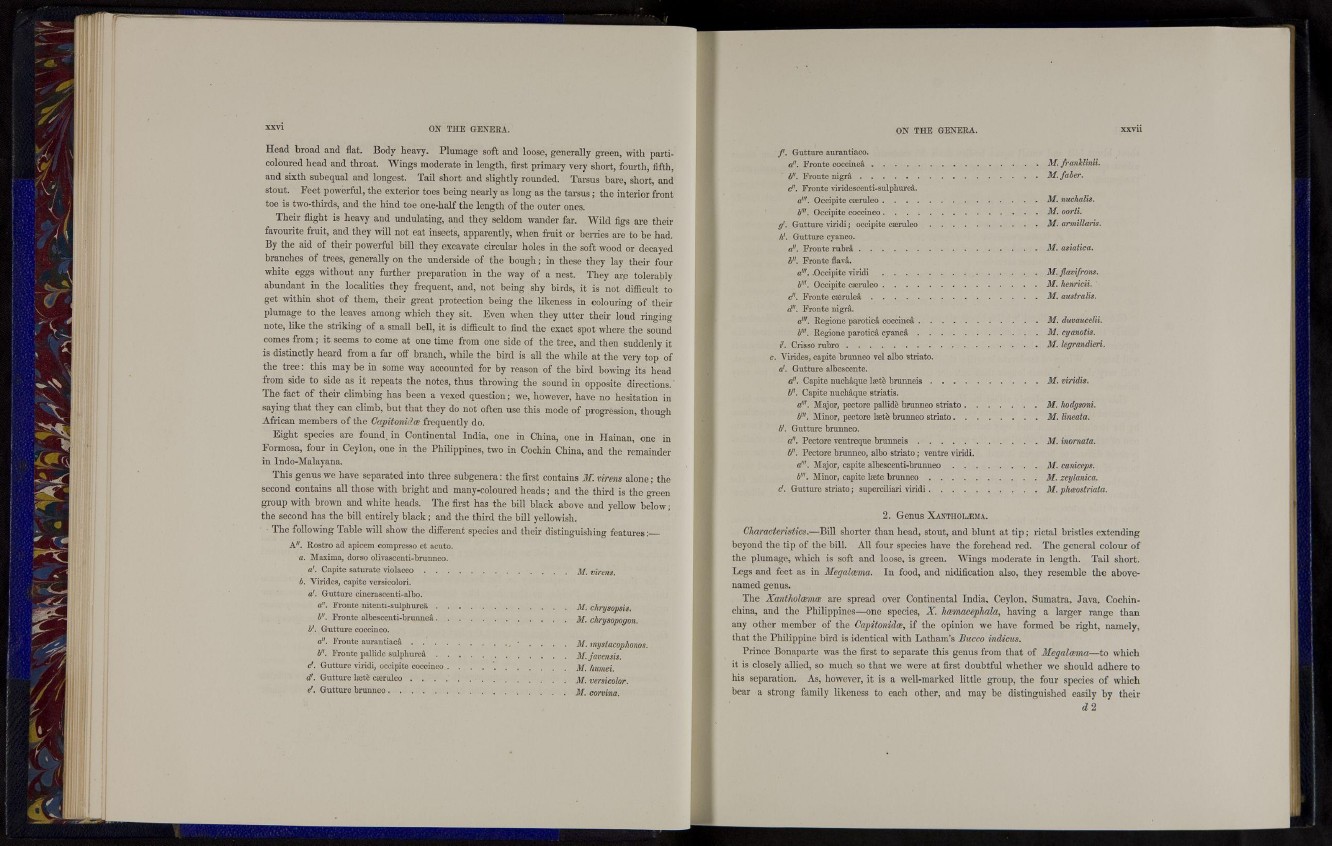
xxvi ON THE GENERA.
Head broad and flat. Body heavy. Plumage soft and loose, generally green, with particoloured
head and throat. Wings moderate in length, first primary very short, fourth, fifth,
and sixth subequal and longest. Tail short and slightly rounded. Tarsus bare, short, and
stout. Feet powerful, t h e exterior toes being nearly as long as the t a r s u s ; the interior front
toe is two-thirds, and t h e hind toe one-half t h e l e n g t h of the outer ones.
Their flight is heavy and undulating, and they seldom wander far. Wild figs are their
favourite fruit, and they will not eat insects, apparently, when fruit or berries are to be had.
By the aid of their powerful bill they excavate circular holes in the soft wood or decayed
branches of trees, generally on the underside of the bough; in these they lay their four
white eggs without any further preparation in the way of a nest. They arp tolerably
abundant in the localities they frequent, and, not being shy birds, it is not difficult to
get within shot of them, their great protection being the likeness in colouring of their
plumage to t h e leaves among which they sit. Even when they utter their loud ringing
note, like t h e striking of a small bell, it is difficult to find the exact spot where the sound
comes from; it seems to come at one time from one side of the tree, and then suddenly it
is distinctly heard from a far off branch, while t h e bird is all the while at the very top of
t h e t r e e : this may be in some way accounted for by reason of the bird bowing its head
from side to side as it repeats the notes, thus throwing the sound in opposite directions.
The fact of their climbing has been a vexed question; we, however, have no hesitation in
saying that they can climb, but that they do not often use this mode of progression, though
African members of t h e Capitonbhc frequently do.
Eight species are found, in Continental India, one in China, one in Hainan, one in
Formosa, four in Ceylon, one in the Philippines, two in Cochin China, and the remainder
in Indo-Malayana.
This genus we have separated into three subgenera: the first contains M. virens alone; the
second contains all those with bright and many-coloured heads; and the t h i r d is t h e green
group with brown and white heads. The first has the bill black above and yellow below;
t h e second has t h e bill entirely black; and the third the bill yellowish.
The following Table will show t h e different species and their distinguishing features:—
A". Rostro ad apicem comprcsso et acuto.
a. Maxima, dorso olivasccnti-brunnco.
a'. Capitc saturate violaceo M. virens.
b. Virides, capitc vcrsicolori.
(J. Gutture cinerasceuti-albo.
a". Fronte nitenti-sulphurea M. chrysopsis.
b". Fronte albesccnti-brunnea M. chrysopogon.
V. Gutture coccinco.
a". Fronte aurantiaca M. mystacophonos.
b". Fronte pallidc sulphurca. M.javensis.
d. Gutture viridi, occipite coccinco M. humei.
d'. Gutture lsete cseruleo M. versicolor.
e'. Gutture brunnco M. corvina.
ON THE GENERA. xxvii
ƒ . Gutture aurantiaco.
a". Fronte coccínea M. franklinii.
¿». Fronte nigrá M.faber.
c". Fronte viridescenti-sulpliurcá.
a'". Occipite cseruleo M. nuchalis.
b'". Occipite coccíneo M. oorti.
g'. Gutture viridi; occipite cseruleo M. armillaris.
h'. Gutture cyanco.
a". Fronte rubra M. asiática.
b". Fronte flava.
a'". .Occipite viridi M. flavifrons.
b'". Occipite cseruleo M. henricii.
c". Fronte caerulea M. australis.
d". Fronte nigrá.
«"'. Rcgionc paroticá coccínea M. duvaucelii.
b'". Regione paroticá cyancá M. cyanotis.
i1. Crisso rubro M. legrandieri.
Virides, capitc brunneo vel albo striato.
a'. Gutture albescente.
a". Capitc nucháque líete brunneis M. viridis.
b". Capitc nucháque striatis.
a1". Major, pectore pallide brunneo striato M. hodgsoni.
ó'". Minor, pectore lseté brunneo striato M. linéala.
U. Gutture brunneo.
a". Pectore ventreque brunneis M. inornata.
b". Pectore brunneo, albo striato; ventre viridi.
a!". Major, capite albesecnti-brunneo M. caniceps.
b'". Minor, capite lsetc brunneo M. zeylanica.
d. Gutture striato; superciliari viridi M. pha>ost?-iata.
2. Genus XANTIIOL^EMA.
Characteristics.—Bill shorter than head, stout, and blunt at t i p ; rictal bristles extending
beyond the tip of the bill. All four species have the forehead red. The general colour of
t h e plumage, which is soft and loose, is green. Wings moderate i n length. Tail short.
Legs and feet as in Megalasma. In food, and nidification also, they resemble the abovenamed
genus.
The Xanthelasmas are spread over Continental India, Ceylon, Sumatra, Java, Cochinchina,
and the Philippines—one species, X. hasmacephala, having a larger range than
any other member of the Capitonidas, if the opinion we have formed be right, namely,
that the Philippine bird is identical with Latham's Bucco indicus.
Prince Bonaparte was the first to separate this genus from that of Megalasma—to which
it is closely allied, so much so t h a t we were at first doubtful whether we should adhere to
his separation. As, however, it is a well-marked little group, the four species of which
bear a strong family likeness to each other, and may be distinguished easily by their
d2